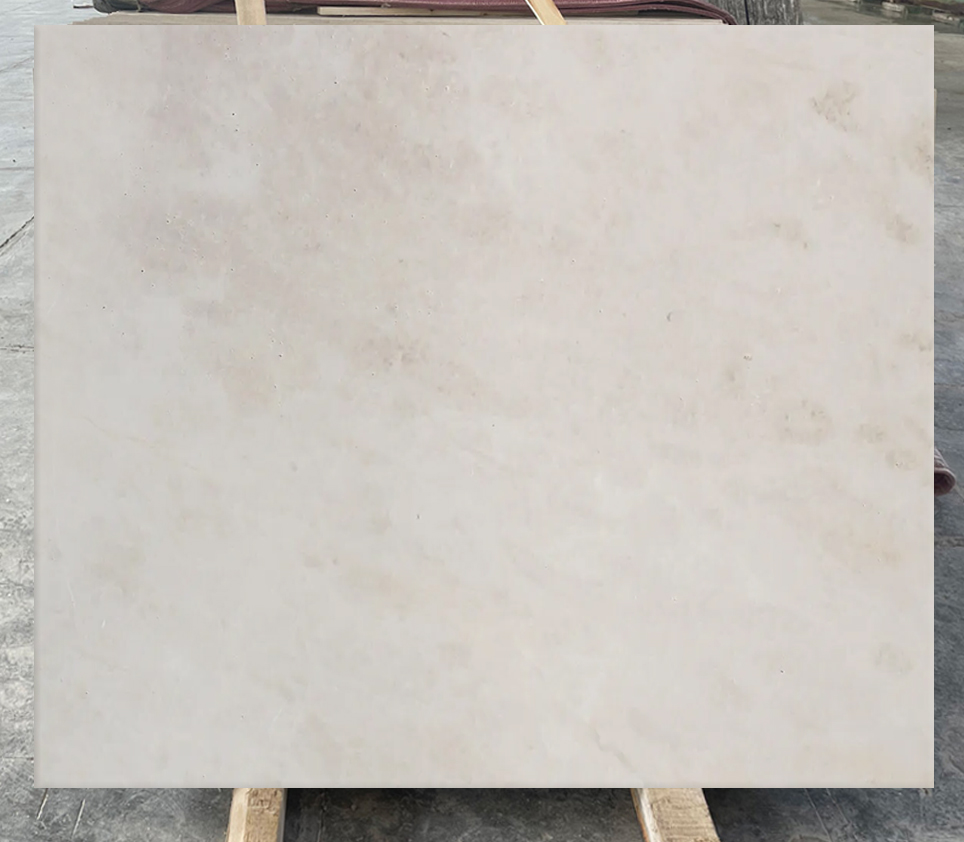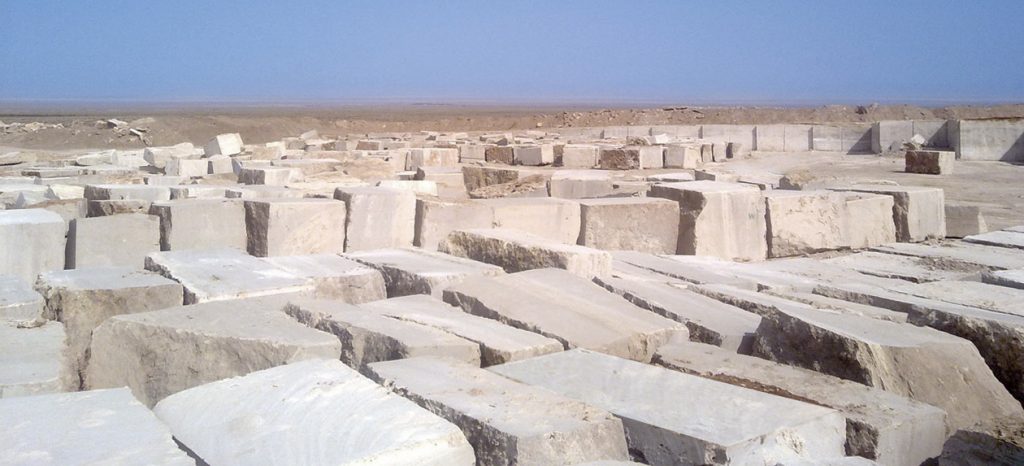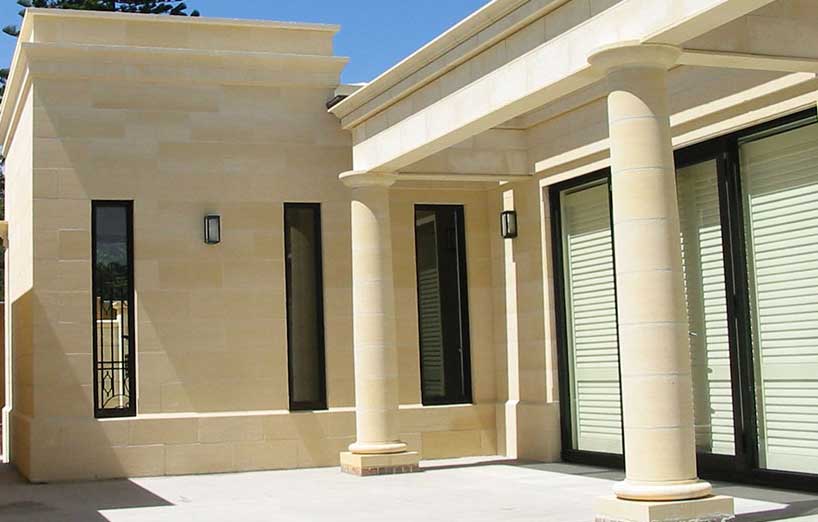Limestone
Limestone, which people often mistake for travertine, constitutes a sedimentary and calcareous rock. This type of stone is utilized for interior decoration in the construction industry. When coated with nanomaterials, limestone can rival white travertine stones. It holds historical significance as one of the earliest rocks employed by humans. Limestone is referred to as the youngest sedimentary rock due to its relatively shorter formation time compared to other sedimentary stones.

Characteristics
Limestone offers a uniform surface texture.
While limestone has a high water absorption rate, advancements in nanotechnology have allowed for treatments that enhance its resistance to water absorption.
The light color of this contributes to a pleasant ambiance when utilized in different architectural areas.
This stone exhibits poor resistance to abrasion and erosion.
Due to its low resistance, stone is susceptible to fractures.
It is prone to chipping when impacted by sharp objects.
This stone is composed of what materials?
This stone, called calcite, forms a calcareous and sedimentary rock.With a lower density compared to marble and dolomite rocks, this stone is lightweight. Its formation involves the presence of other materials, including argonite, dolomite, quartz, feldspar, hematite, and limonite. These rocks also contain visible fossil structures. They originate in marine environments, especially shallow seas, where factors such as temperature, water salinity, and concentration play a significant role in their formation.

.
Applications of Limestone
This stone does not serve as a suitable choice for exterior building facades and is better utilized in outdoor spaces. Another drawback of this stone is its high water absorption and low resistance to erosion, which limits its use in areas with heavy foot traffic and high water exposure.
Now let’s explore some of the applications of this stone:
Flooring and staircases
Parking lot surfaces and their walls
Staircase walls
Elevator surrounds
Window surrounds
Staircase balustrades
Decorative elements
Construction of thresholds
Sculptures

Advantages:
- The uniform and smooth surface of limestone enhances the beauty and harmony of the building facade.
- This stone is cost-effective, making it a favorable choice for large construction projects.
- The significant price difference compared to travertine and easier cutting are additional advantages of limestone.
- This stone weighs less compared to travertine, which is a positive characteristic.
- The absence of cracks and veins in this stone ensures its durability and structural integrity.
- The large size and dimensions of limestone stones are another advantage.
Disadvantages:
- The water absorption rate of limestone is high.
- Its resistance to pressure is low.
- Moisture is easily absorbed by limestone.
- Cutting limestone is more challenging compared to stones like marble.
- After cutting, limestone may warp and change dimensions due to its high absorption.
- This stone is not suitable for use in northern regions of the country due to its water absorption.
- Limited resistance to erosion is one of the drawbacks of this stone.
- One of the major disadvantages of limestone is its tendency to stain.
Limestone Mines
The cities of Islamabad Kermanshah, Samirum Isfahan, and Mahmoudabad Isfahan are among the main mines extracting limestone.
Additionally, the cities of Mahabad, Bojnourd, Gohar, Boukan, and Marvdasht in Fars province are other mines extracting this stone.
Price
Like other building stones, several factors affect the price of limestone, including:
- Quality and grade of the stone (higher quality results in higher prices)
- Color and pattern of the stone (lighter and more uniform this stone commands higher prices)
- Porosity of the stone (less porous stones have higher prices)
- Size and dimensions of the stone (larger stones have higher production costs)
- Preparation type
- Processing
- Level of polish
- Packaging method
- Transportation method
- Quality of resin and backing mesh
- Thickness of the stone
- Substrate level
Comparison of Limestone with Marble

Limestone forms more quickly compared to marble, which requires a longer time as it originates from the sedimentation of calcareous minerals.
Transportation and installation costs are higher for marble compared to limestone.
Marble stone is more commonly used in exterior facades, while limestone is more prevalent in interior applications.
Marble exhibits greater resistance to weather fluctuations compared to this stone.
This stone is made of limestone but offers greater variety, while limestone is generally available in white and cream colors.
Types of Iranian limestone
Gohareh Stone
Miners extract Gohareh Stone from the mines in Khorramabad City, located in Lorestan Province. This stone exhibits a light cream background, with occasional brown-colored veins visible in weaker cases. It has gained renown and finds utilization in various European and American countries. Gohareh Stone finds applications in interior walls of buildings, interior decoration, stairs, and corridors.
Kermanshah Stone
Miners extract Kermanshah Stone, which resembles Islamabad Stone and Vang Stone, in Kermanshah Province. It has a light cream background that tends towards white. This stone is primarily used in interior walls of buildings that do not come into contact with moisture.
Limestone Stone in Bukhara
Miners extract Bukhara Stone from Bukhara County, situated in West Azerbaijan Province. It features a surface with visible yellow grains and lines on a white and cream background. This versatile stone finds application in both interior and exterior building facades. Additionally, it is employed in crafting stone artifacts like sculptures and gravestones.
Mahabad Stone
Miners extract Mahabad Stone from the mines in Mahabad County, located in West Azerbaijan Province. This stone features a colorful background and finds particular usage in interior walls and building facades, especially in secondary parts of the structure. However, it exhibits lower resistance to factors such as weathering and sunlight.
Marvdasht Stone
Miners extract this stone from Marvdasht County, which is near Shiraz. Marvdasht limestone stone features a smooth and uniform surface with a white background. It finds application in interior facades of buildings, walls, parking areas, stone volumes, and decorative stone artifacts.
Contact us for more information and to buy this stone
Other recommended stones







2 responses to “Limestone”
[…] Limestone […]
[…] Limestone […]